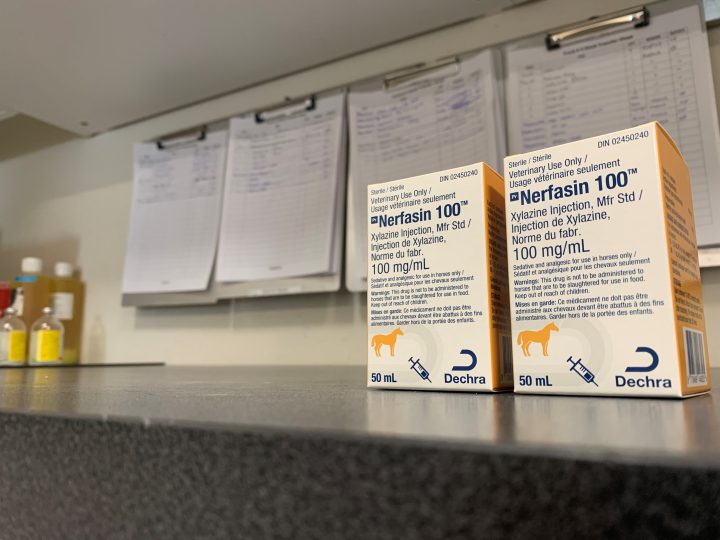EDITOR’S NOTE: This article has been altered to remove information that is not publicly released at this time. It will be updated when the information becomes publicly available.

Animal tranquilizer xylazine is now suspected to be in drugs in southern Alberta, according to a drug alert issued by The Blood Tribe Department of Health (BTDH).
“This may be in addition to other substances as well, which is causing prolonged adverse effects and increased risk of overdose and death,” reads a statement from BTDH, issued on March 24.
“While we have had Xylazine in the area previously, at this time there are new and very serious adverse effects that are occurring, such as stroke-like symptoms where people may seem OK one moment and then have severe symptoms thereafter,” reads the statement.
The statement says users can experience blackout states for hours, where they are not aware what is occurring around them.
Xylazine is an animal tranquilizer normally prescribed for horses and cattle, also known as “the zombie drug.”
South of the border, the U.S. Drug Enforcement Administration issued a warning about a sharp increase in the trafficking of fentanyl mixed with xylazine, a combination known as “tranq.”
“Xylazine is making the deadliest drug threat our country has ever faced — fentanyl — even deadlier,” said administrator Anne Milgram.
Health Canada says it’s receiving an increasing number of illegal drug samples that contain xylazine.
Dr. Monty Ghosh, an internist and addiction specialist who works at the University of Alberta Hospital in Edmonton as well as the Foothills and Rockyview Hospitals, said the alert for the Blood Reserve indicates xylazine is starting to creep into the province’s drug supply.
“We have to be very careful. This is definitely brand-new territory for a lot of us,” said Ghosh.
“What happens there does happen in Edmonton and Calgary, so it’s just a matter of time before we start seeing it on our streets and into our population. We all have to be very careful and exercise extreme caution with the drug supply.”
Xylazine constricts blood vessels, which Ghosh said can eventually lead to the loss of fingers and toes.
“If the blood flow decreases to certain areas, it can get necrotic and when it becomes necrotic, it can result in gangrene and can be infected,” Ghosh said.
Dealers use cheaper substances to cut, or dilute, popular drugs, stretching their supply to create more profit.
- Buzz kill? Gen Z less interested in coffee than older Canadians, survey shows
- ‘She gets to be 10’: Ontario child’s heart donated to girl the same age
- Bird flu risk to humans an ‘enormous concern,’ WHO says. Here’s what to know
- Canada updating sperm donor screening criteria for men who have sex with men
The result: a more unpredictable and potent drug supply.
Alberta, B.C. and Ontario are the provinces with most reported cases of xylazine.
Adding to the problem is the fact that xylazine is not an opioid, meaning naloxone is not able to counter it.
“Our biggest concern at this moment is that it will lessen the effects of drug reversals and it will cause a spike in mortality rates, and we really aren’t sure what we’re dealing with,” Ghosh said.
Naloxone does not work on xylazine, but giving naloxone is still recommended with an overdose as there may be other substances on which naloxone could be effective.
Health Canada says since 2019, there has been an increase in the number of xylazine identifications in samples submitted to the Drug Analysis Service (DAS) by Canadian law enforcement agencies.
According to a spokesperson for Alberta Mental Health and Addiction, since January 2019, the Office of the Chief Medical Examiner (OCME) reported the presence of a low concentration of xylazine in 43 deaths. Fentanyl was detected in all of these cases.
The spokesperson said all illicit drugs should always be considered dangerous and potentially deadly.
“We have been investing in a number of initiatives to address the addiction crisis, such as increasing the number of addiction treatment spaces, building recovery communities, eliminating fees for residential addiction treatment, launching the Digital Overdose Response System (DORS) app and expanding access to opioid agonist treatment,” said Colin Aitchison senior press secretary on Monday.
Combined with Alberta Health Services, Alberta spends more than $1 billion per year on addiction and mental health programs and services.
More than 5,360 Canadians died of an overdose from January to September 2022.
“Today’s national data release on opioid- and stimulant-related harms is another tragic reminder that the toxic drug and overdose crisis is one of the most serious and unprecedented public health threats in Canada’s history,” said Carolyn Bennett, federal minister of mental health and addictions, in a statement Monday.
“While this data shows a decrease in deaths from January to September 2022 compared to the same period in 2021, the figures are still too high,” Bennett said.


Comments